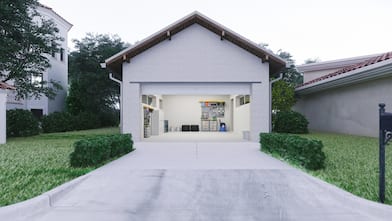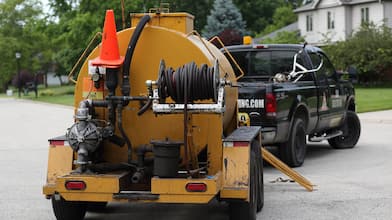Prevent your driveway from flaking out on you with these five tips
Concrete spalling may not be one of the driveway terms you know, but you should add it to your priority list when it comes to outdoor comfort and curb appeal.
Also called scaling, spalling happens when cement paste particles flake or peel near the surface of a concrete slab. The smooth top layer of your driveway is about one-sixteenth of an inch thick, and once the chips that result from spalling reach five millimeters or deeper, you’ll see the rough, gravely concrete beneath the surface.
When it comes to spalling, there are red flags to watch for—cracks, chips, patches of coarse or uneven concrete, and exposed mesh or rebar are all telltale signs of a problem.
Over time, and under certain conditions, spalling becomes an unsightly threat to the structure of your driveway. The only solutions are driveway patching and resurfacing. Fortunately, there are some steps you can take to prevent spalling before it happens.
1. Install the Driveway In Temperate Weather
It’s best to lay your new driveway when the weather is mild. Think comfortable temperatures—not too cold, not too hot.
Cold Climates and Spalling
The problem of concrete spalling is most common in colder climates. Concrete is porous, so water collects beneath its surface. When temperatures dip below freezing, the concrete expands with the water, creating pressure that leads to flaking.
If the temperature is below freezing when your contractor pours the concrete, the top layer can freeze immediately, setting it up to peel off within 30 days. With the top layer gone, all that’s left is jagged concrete. A good contractor will cover the driveway overnight with concrete curing blankets when pouring concrete in the winter—just know that this could add several hundred dollars to your bill.
Hot Climates and Spalling
Sorry, but warm weather driveways aren’t off the hook either—high temps and blazing sunshine can cause thermal expansion that chips away at the material. Not cool, literally.
Also, concrete can set too quickly if it’s too hot out, forcing contractors to add water to finish the project. That excess moisture can get trapped in the concrete mix and lead to scaling.
2. Hire the Right Contractor
The most common causes of concrete spalling begin before anyone sets foot on your finished driveway. Improperly poured or finished concrete can make your driveway more vulnerable to spalling.
Installation missteps that can create or lead to spalling include:
The use of worn-out tools with broken or uneven edges
Pouring an overly-watery mixture that doesn’t include air-entrained concrete, includes too many accelerants or retarders, or is ill-suited to the climate
Finishing the job too quickly for the concrete to properly set
Improper curing
Faulty grading around the driveway that doesn’t carry water away from the concrete surface
Failure to properly embed rebar
Pouring a concrete driveway is a complex task that requires perfect timing and specialized tools, so it’s not often feasible for DIYers. A trustworthy local concrete driveway contractor can tackle the job for you. Ask your pro what they do to avoid spalling and whether they offer free repairs if it happens relatively soon after installation.
3. Add a Sealant

There are many concrete sealants you can apply to resist moisture and prevent spalling.
Densifiers add a strong crystalline barrier to the concrete’s pores. They won’t prevent the root cause of spalling, but they will help avoid damage.
Waterproof sealants can reduce concrete’s moisture absorption by as much as 95%. Water repellent sealants won’t eliminate the risk of spalling, but they’ll certainly help reduce it.
The concrete should sit for about 60 days after it's poured to reach full strength, and you should apply sealant right after. If you’re using both a densifier and a water repellant, apply the former first and the latter five to seven days later. You should replace water repellent sealant once every five years. Expect to pay between $0.50 and $2.50 per square foot.
4. Ditch the Deicing Salt
Deicing salt is a common spalling culprit. Rock salts that include chloride will eat away at the surface of your driveway, destroying the top layer, and letting water inside. This is one reason spalling is common in cold climates.
If you’re worried about spalling, stick to shoveling and snow-blowing when the icy months hit. If you must use a deicing salt, wait at least six months after installing a driveway. Also, keep an eye on your tires and vary where you park cars—even if you don’t apply deicing agents yourself, your tires will pick them up on public roads and deposit them on your concrete.
5. Keep Your Driveway Clean
The general wear and tear that results from regular use can also lead to spalling over time. Beyond the steps you might take to ensure proper installation and avoid the risks posed by moisture and the freeze-thaw cycle, staying on top of regular maintenance and cleaning is the best thing you can do to prevent spalling and extend the life of your driveway.





